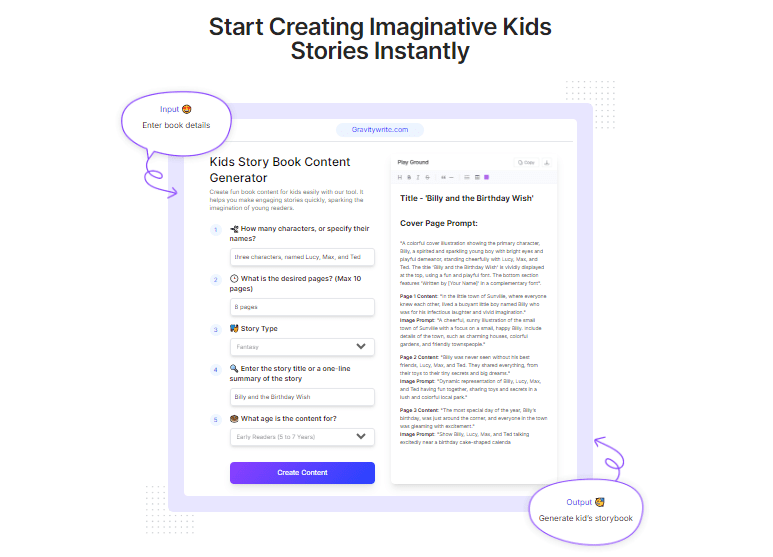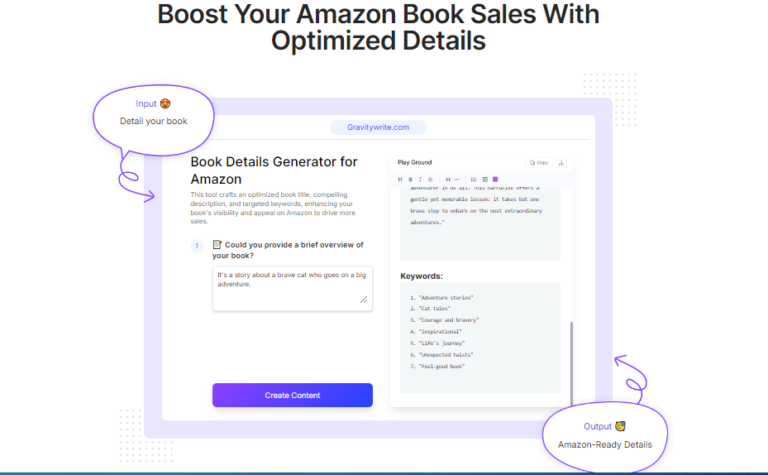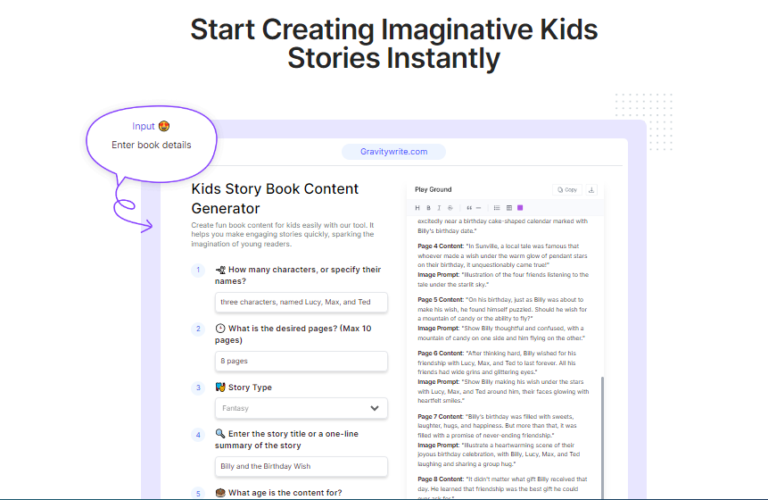A comprehensive guide on writing a children’s book, covering essential steps, tips, and FAQs. Learn how to craft captivating stories, engaging characters, and vibrant illustrations for young readers.
Introduction
Embark on a journey of imagination and creativity as you discover the art of writing children’s books. This comprehensive guide will equip you with the essential tools and techniques to craft captivating narratives that resonate with young minds. From developing engaging characters to weaving enchanting plots, we’ll explore every aspect of the writing process, ensuring your stories come alive on the page.
Watch How GravityWrite Creates Story Book for Kids in Seconds!
Get Started With GravityWrite Today!
I. The Foundation of Storytelling:
A. Understanding Your Audience:
Age Group and Interests:
- Consider the age range you want to target (e.g., preschoolers, elementary school students, or tweens).
- Identify their interests and experiences to tailor your story accordingly.
Reading Levels and Comprehension:
- Understand the appropriate reading level for your target age group.
- Use simple language and sentence structures to make your story accessible.
Cultural and Social Backgrounds:
- Be mindful of cultural and social sensitivities.
- Avoid stereotypes and ensure your characters and stories are inclusive.
B. Developing a Captivating Theme:
Central Message or Moral:
- Determine the underlying message or moral you want to convey.
- Ensure it is appropriate for your target audience and aligns with your story’s purpose.
Relatability and Universality:
- Choose themes that children can relate to and understand.
- Explore universal experiences and emotions that resonate with young readers.
Themes that Inspire and Educate:
- Select themes that inspire curiosity, imagination, and learning.
- Consider topics such as friendship, courage, kindness, and perseverance.
II. Crafting Engaging Characters:
A. Creating Memorable Protagonists:
Unique Traits and Quirks:
- Give your protagonist distinctive characteristics that make them memorable.
- Explore their strengths, weaknesses, fears, and dreams.
Growth and Development Throughout the Story:
- Show how your protagonist changes and grows over time.
- Demonstrate their personal journey and lessons learned.
Relatable Struggles and Triumphs:
- Create challenges and obstacles that your protagonist can overcome.
- Celebrate their victories and inspire young readers to believe in themselves.
B. Building Compelling Antagonists:
Opposing Forces and Conflicts:
- Introduce a character or force that opposes your protagonist.
- Create a conflict that drives the story forward.
Internal and External Challenges:
- Explore the antagonist’s motivations and goals.
- Consider both internal struggles and external obstacles.
Motivation and Backstory:
- Give your antagonist a compelling backstory that explains their actions.
- Make them a believable and interesting character.
C. Supporting Cast and Their Roles:
Diverse and Interesting Characters:
- Create a cast of supporting characters who are unique and engaging.
- Ensure they contribute to the story’s plot and theme.
Contributions to the Plot and Theme:
- Give each character a specific role and purpose.
- Explore how they interact with the protagonist and influence the story’s outcome.
Relationships and Interactions:
- Develop meaningful relationships between characters.
- Show how they support, challenge, or conflict with each other.
III. Weaving a Compelling Plot:
A. Developing a Strong Narrative Structure:
Exposition, Rising Action, Climax, Falling Action, Resolution:
- Follow a classic story structure to guide your narrative.
- Introduce characters, setting, and conflict in the exposition.
- Build tension and suspense in the rising action.
- Create a dramatic climax where the conflict is resolved.
- Tie up loose ends and provide a satisfying conclusion.
Pacing and Tension:
- Vary the pace of your story to keep readers engaged.
- Create moments of suspense and excitement.
Clear Beginning, Middle, and End:
- Ensure your story has a well-defined beginning, middle, and end.
- Provide a clear sense of direction and purpose.
B. Creating Conflict and Challenges:
Internal and External Obstacles:
- Introduce both internal and external challenges for your characters.
- Explore their struggles, fears, and conflicts.
Stakes and Consequences:
- Raise the stakes to increase tension and suspense.
- Show the potential consequences of the characters’ actions.
Overcoming Adversity:
- Demonstrate how your characters overcome challenges and learn valuable lessons.
- Inspire young readers to persevere and believe in themselves.
C. Incorporating Themes and Messages:
Subtle and Implicit Integration:
- Weave your theme into the story subtly and naturally.
- Avoid overt preaching or moralizing.
Relevance to the Story and Characters:
- Ensure your theme is relevant to the plot and characters.
- Show how it connects to their experiences and challenges.
Educational and Inspirational Value:
- Choose themes that inspire curiosity, learning, and positive values.
- Create stories that educate and empower young readers.
Get Started With GravityWrite Today!
IV. The Power of Language and Style:
A. Simple and Clear Language:
Vocabulary Appropriate for Age Group:
- Use words and phrases that are appropriate for your target audience.
- Avoid overly complex or unfamiliar language.
Sentence Structure and Pacing:
- Keep sentences short and to the point.
- Vary sentence length and structure to maintain interest.
Avoiding Complexity and Jargon:
- Avoid technical terms or jargon that may confuse young readers.
- Use clear and concise language throughout your story.
B. Vivid Imagery and Sensory Details:
Show, Don’t Tell Technique:
- Use vivid descriptions to paint a picture in the reader’s mind.
- Show rather than tell the reader what is happening.
Engaging the Reader’s Senses:
- Appeal to the reader’s senses of sight, sound, touch, taste, and smell.
- Create a sensory experience that immerses them in the story.
Creating a Mental Picture:
- Help readers visualize the setting, characters, and events.
- Use descriptive language to evoke emotions and imagination.
C. Dialogue and Character Voices:
Authentic and Believable Conversations:
- Write dialogue that sounds natural and realistic.
- Avoid overly formal or stilted language.
Reflecting Individual Personalities:
- Use dialogue to reveal the unique personalities of your characters.
- Consider their speech patterns, vocabulary, and mannerisms.
Moving the Story Forward:
- Use dialogue to advance the plot and reveal important information.
- Avoid unnecessary dialogue that does not contribute to the story.
V. Illustrating Your Story:
A. The Importance of Visuals:
Enhancing the Narrative:
- Illustrations can enhance the story by adding visual elements.
- They can help clarify meaning, create mood, and engage young readers.
Engaging Young Readers:
- Visuals can capture the attention of young readers and make the story more appealing.
- They can help children understand complex concepts or emotions.
Supporting the Text:
- Illustrations can complement the text and provide additional context.
- They can help visualize scenes and characters.
B. Choosing an Illustrator:
Style and Aesthetic:
- Look for an illustrator whose style and aesthetic aligns with your vision.
- Consider the tone and mood you want to convey.
Experience and Expertise:
- Choose an illustrator with experience in illustrating children’s books.
- Look for someone who understands the needs and preferences of young readers.
Collaboration and Feedback:
- Be open to collaboration and provide clear feedback to your illustrator.
- Ensure that the illustrations complement your story and enhance the overall experience.
C. Incorporating Illustrations into the Text:
Placement and Sequencing:
- Determine the best placement for illustrations throughout your book.
- Consider the flow of the story and the visual impact of the illustrations.
Visual Storytelling:
- Use illustrations to tell part of the story visually.
- Consider creating a storyboard to plan the sequence of illustrations.
Complementing the Narrative:
- Ensure the illustrations support and enhance the text.
- Avoid illustrations that contradict or distract from the story.
VI. Revising and Editing:
A. The Importance of Feedback:
Seeking Input from Others:
- Get feedback from friends, family, or writing groups.
- Consider sharing your manuscript with beta readers or professional editors.
Constructive Criticism:
- Be open to constructive criticism and use it to improve your story.
- Consider feedback on plot, characters, language, and overall impact.
Peer Review and Professional Editing:
- Join a writing group or hire a professional editor to provide expert feedback.
- They can help identify weaknesses and suggest improvements.
B. Tightening the Prose:
Eliminating Unnecessary Words and Phrases:
- Cut out any words or phrases that do not add value to your story.
- Focus on clarity and conciseness.
Improving Clarity and Conciseness:
- Rewrite sentences that are unclear or overly complex.
- Use strong verbs and avoid passive voice.
Enhancing Flow and Rhythm:
- Pay attention to the rhythm and cadence of your writing.
- Use varied sentence lengths and structures to maintain interest.
C. Polishing the Dialogue and Character Voices:
Ensuring Authenticity and Consistency:
- Make sure your dialogue sounds natural and believable.
- Avoid clichés or overly formal language.
Refining Nuances and Subtext:
- Consider the underlying meaning or subtext of your dialogue.
- Use subtle cues to convey emotions and intentions.
Making Characters Come Alive:
- Use dialogue to bring your characters to life.
- Allow their personalities and quirks to shine through.
Get Started With GravityWrite Today!
VII. Publishing Your Children’s Book:
A. Traditional Publishing:
Agents and Submission Process:
- Research literary agents who represent children’s books.
- Prepare a query letter and submit your manuscript to agents.
Publishing Contracts and Royalties:
- If accepted, negotiate a publishing contract with the publisher.
- Understand the terms of the contract, including royalties and rights.
Marketing and Distribution:
- The publisher will typically handle marketing and distribution.
- They will work to promote your book and get it into bookstores.
B. Self-Publishing:
Platforms and Services:
- Choose a self-publishing platform or service that meets your needs.
- Consider factors such as costs, services offered, and ease of use.
Design and Formatting:
- Create a professional book cover and interior design.
- Ensure the formatting is consistent and visually appealing.
Marketing and Promotion:
- Take responsibility for marketing and promoting your book.
- Utilize social media, book fairs, and other channels to reach your audience.
C. Hybrid Publishing:
Combining Traditional and Self-Publishing:
- Explore hybrid publishing options that combine elements of traditional and self-publishing.
- Consider working with a hybrid publisher that offers both services.
Benefits and Considerations:
- Hybrid publishing can provide a balance of control and reach.
- Consider the costs, terms, and services offered by different hybrid publishers.
Balancing Control and Reach:
- Evaluate the level of control you want over your book versus the reach and distribution offered by a publisher.
Frequently Asked Questions (FAQs):
A. How do I find a unique and original story idea?
- Explore personal experiences, interests, and passions.
- Read widely and draw inspiration from classic and contemporary children’s literature.
- Brainstorm ideas with friends, family, or writing groups.
B. What is the best age to start writing children’s books?
- There is no age limit to start writing children’s books.
- Children as young as 7 or 8 can begin to experiment with storytelling.
- Adults can also write children’s books with great success.
C. How can I make my characters relatable to young readers?
- Give your characters relatable emotions, experiences, and challenges.
- Avoid making them perfect or too idealized.
- Show how they overcome obstacles and learn valuable lessons.
D. What is the best way to get feedback on my manuscript?
- Join a writing group or workshop.
- Share your work with friends, family, or beta readers.
- Hire a professional editor for a comprehensive evaluation.
E. How do I choose the right illustrator for my book?
- Look for an illustrator whose style and aesthetic aligns with your vision.
- Consider their experience and expertise in illustrating children’s books.
- Research their portfolio and read testimonials from previous clients.
F. What are the costs involved in self-publishing a children’s book?
- Costs can vary depending on the services you choose.
- Factors to consider include editing, design, printing, and marketing.
- Research different self-publishing platforms and compare their pricing.
G. How can I market and promote my children’s book?
- Utilize social media platforms to reach your target audience.
- Network with other authors and booksellers.
- Attend book fairs and literary events.
- Consider running targeted advertising campaigns.
Get Started With GravityWrite Today!
Conclusion:
Writing a children’s book is a rewarding and fulfilling endeavor. By following the guidelines outlined in this comprehensive guide, you can craft captivating stories that inspire, entertain, and educate young readers. Remember, the most important thing is to let your imagination soar and have fun with the writing process. With dedication, creativity, and a touch of magic, you can create timeless stories that will be cherished for generations to come.
Discover more from ZornSoftware
Subscribe to get the latest posts sent to your email.



